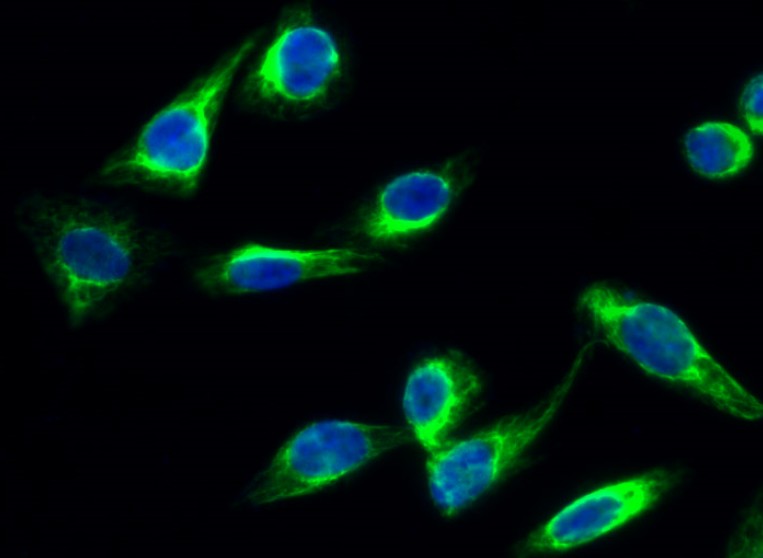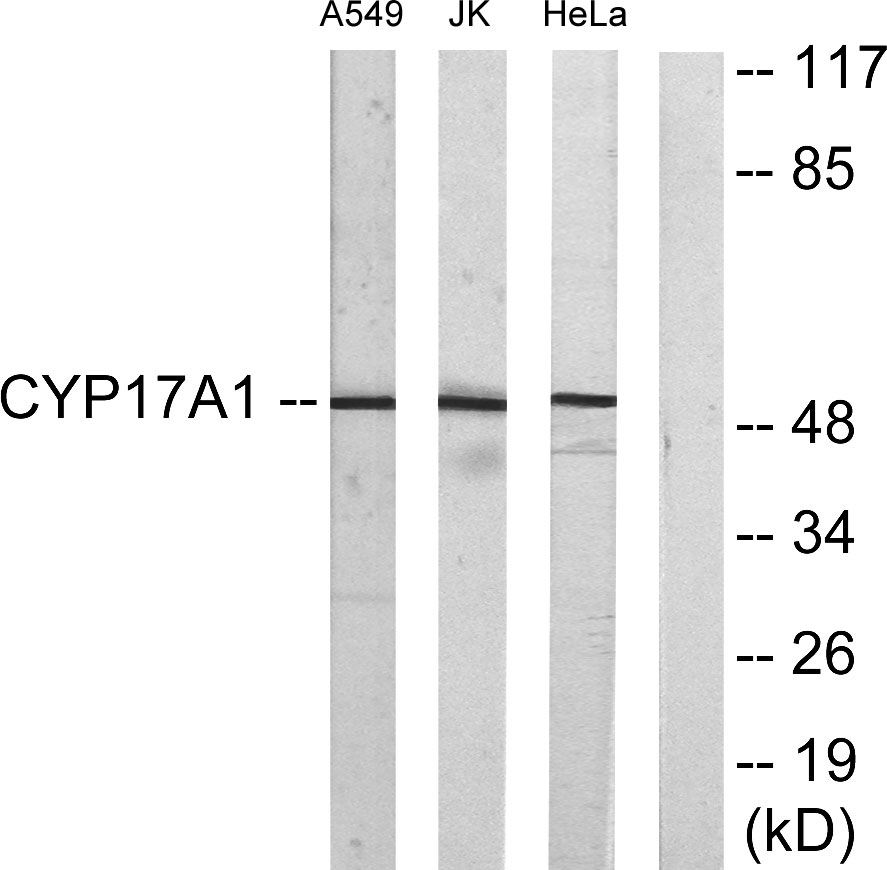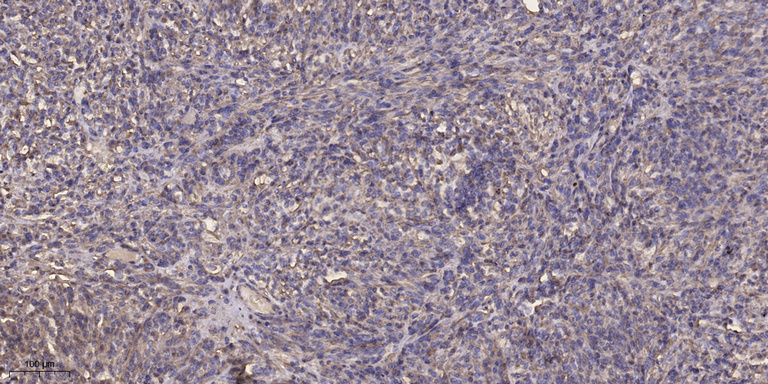CYP17A1 Polyclonal Antibody
- Catalog No.:YT1189
- Applications:WB;IHC;IF;ELISA
- Reactivity:Human
- Target:
- CYP17A1
- Fields:
- >>Steroid hormone biosynthesis;>>Metabolic pathways;>>Ovarian steroidogenesis;>>Prolactin signaling pathway;>>Cortisol synthesis and secretion;>>Cushing syndrome
- Gene Name:
- CYP17A1
- Protein Name:
- Steroid 17-alpha-hydroxylase/17,20 lyase
- Human Gene Id:
- 1586
- Human Swiss Prot No:
- P05093
- Mouse Swiss Prot No:
- P27786
- Immunogen:
- The antiserum was produced against synthesized peptide derived from human Cytochrome P450 17A1. AA range:221-270
- Specificity:
- CYP17A1 Polyclonal Antibody detects endogenous levels of CYP17A1 protein.
- Formulation:
- Liquid in PBS containing 50% glycerol, 0.5% BSA and 0.02% sodium azide.
- Source:
- Polyclonal, Rabbit,IgG
- Dilution:
- WB 1:500 - 1:2000. IHC 1:100 - 1:300. IF 1:200 - 1:1000. ELISA: 1:10000. Not yet tested in other applications.
- Purification:
- The antibody was affinity-purified from rabbit antiserum by affinity-chromatography using epitope-specific immunogen.
- Concentration:
- 1 mg/ml
- Storage Stability:
- -15°C to -25°C/1 year(Do not lower than -25°C)
- Other Name:
- CYP17A1;CYP17;S17AH;Steroid 17-alpha-hydroxylase/17;20 lyase;CYPXVII;Cytochrome P450 17A1;Cytochrome P450-C17;Cytochrome P450c17;Steroid 17-alpha-monooxygenase
- Observed Band(KD):
- 50kD
- Background:
- cytochrome P450 family 17 subfamily A member 1(CYP17A1) Homo sapiens This gene encodes a member of the cytochrome P450 superfamily of enzymes. The cytochrome P450 proteins are monooxygenases which catalyze many reactions involved in drug metabolism and synthesis of cholesterol, steroids and other lipids. This protein localizes to the endoplasmic reticulum. It has both 17alpha-hydroxylase and 17,20-lyase activities and is a key enzyme in the steroidogenic pathway that produces progestins, mineralocorticoids, glucocorticoids, androgens, and estrogens. Mutations in this gene are associated with isolated steroid-17 alpha-hydroxylase deficiency, 17-alpha-hydroxylase/17,20-lyase deficiency, pseudohermaphroditism, and adrenal hyperplasia. [provided by RefSeq, Jul 2008],
- Function:
- catalytic activity:A steroid + AH(2) + O(2) = a 17-alpha-hydroxysteroid + A + H(2)O.,cofactor:Heme group.,disease:Defects in CYP17A1 are the cause of adrenal hyperplasia type 5 (AH5) [MIM:202110]. AH5 is a form of congenital adrenal hyperplasia, a common recessive disease due to defective synthesis of cortisol. Congenital adrenal hyperplasia is characterized by androgen excess leading to ambiguous genitalia in affected females, rapid somatic growth during childhood in both sexes with premature closure of the epiphyses and short adult stature. Four clinical types: "salt wasting" (SW, the most severe type), "simple virilizing" (SV, less severely affected patients), with normal aldosterone biosynthesis, "non-classic form" or late onset (NC or LOAH), and "cryptic" (asymptomatic).,enzyme regulation:Regulated predominantly by intracellular cAMP levels.,function:Conversion of pregnenolone and p
- Subcellular Location:
- Endoplasmic reticulum membrane . Microsome membrane .
- Expression:
- Brain,Corpus callosum,
- June 19-2018
- WESTERN IMMUNOBLOTTING PROTOCOL
- June 19-2018
- IMMUNOHISTOCHEMISTRY-PARAFFIN PROTOCOL
- June 19-2018
- IMMUNOFLUORESCENCE PROTOCOL
- September 08-2020
- FLOW-CYTOMEYRT-PROTOCOL
- May 20-2022
- Cell-Based ELISA│解您多样本WB检测之困扰
- July 13-2018
- CELL-BASED-ELISA-PROTOCOL-FOR-ACETYL-PROTEIN
- July 13-2018
- CELL-BASED-ELISA-PROTOCOL-FOR-PHOSPHO-PROTEIN
- July 13-2018
- Antibody-FAQs
- Products Images

- Immunofluorescence analysis of Hela cell. 1,CYP17A1 Polyclonal Antibody(green) was diluted at 1:200(4° overnight). 2, Goat Anti Rabbit Alexa Fluor 488 Catalog:RS3211 was diluted at 1:1000(room temperature, 50min). 3 DAPI(blue) 10min.

- Western Blot analysis of 293 cells using CYP17A1 Polyclonal Antibody diluted at 1:2000

- Western blot analysis of lysates from Jurkat, A549, and HeLa cells, using Cytochrome P450 17A1 Antibody. The lane on the right is blocked with the synthesized peptide.

- Immunohistochemical analysis of paraffin-embedded human Colon cancer. 1, Antibody was diluted at 1:200(4° overnight). 2, Tris-EDTA,pH9.0 was used for antigen retrieval. 3,Secondary antibody was diluted at 1:200(room temperature, 45min).



